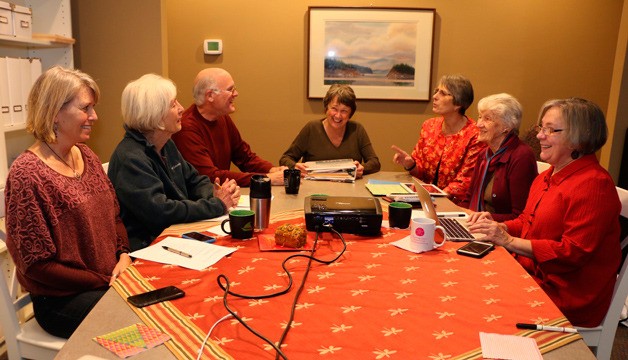There are now more “seniors” than school children.
At least, that’s what a graph on the Bainbridge Public Library’s “Public Demographics” page says.
In studying U.S. Census data, Rod Stevens found that, between 2000 and 2010, the 60-plus set was the fasting growing population on the island. What’s more, every other age group (under 5, 5 to 17, 18 to 34, 35 to 59) remained nearly stagnant. “Seniors” accounted for 90 percent of the overall growth in population.
Several weeks ago, Judy McKenzie shared this statistic at a workshop held at the Waterfront Community Center, attended by 50 or so mostly gray-haired folks.
“I think our culture sort of suggests we don’t have a future,” said McKenzie, who is 75. “But the Village is about taking charge.”
Founded in 1999 by a group of friends in Central Boston, the Village is a grassroots movement for people who want to age in their own homes and take care of themselves and each other, instead of ending up in retirement communities.
Members pay a small fee to be supported by and connected to vetted service providers. By dialing just one number, they gain access to a slew of services — most of them discounted and some of them free — from transportation to health care to companionship.
The concept has spread to 200 communities, with another 150 in progress. Island residents have batted the idea around for a few years, but at a community conversation organized by Sue Barrington this past February, it finally picked up steam.
Despite gorgeous weather, 70 people showed up, and their chief criticism at the end of the four-hour meeting was that they didn’t have enough time, Barrington said.
“Obviously, there was some real meat there,” she added.
Intrigued by what they heard, McKenzie and her husband John volunteered to be the planning facilitators for the project.
With their joint backgrounds in strategic planning and organizational development — the McKenzies had a consulting business for 10 years, and before that, Judy led a nonprofit with a $5 million budget — she figured they could help make the village a reality.
Their first task is to find out if there is enough support for the project, which “is not a foregone conclusion,” McKenzie said.
A steering committee of 18, co-led by Steve Walker and Sandy White, is in charge of developing a work plan and determining the project’s sustainability. They’re joined by representatives from Housing Resources Bainbridge, Island Volunteer Caregivers and even the city.
To gauge interest, the committee has started to distribute needs assessments, which will be followed by listening tours and interviews with the boards of existing nonprofits.
“We’re really trying to figure out how we can do this right,” McKenzie said.
She can think of plenty of reasons that Bainbridge is ripe for a village: an aging population, a culture of leadership, a strong network of existing services.
“The engagement of retired people here and other service agencies is really quite incredible,” McKenzie said.
“That might lead you to say that we don’t need a village because we already have one,” she added. “But a village would help strengthen [the community]. It would also help to coordinate the services, increase access and redefine the notion of asking for help.
“Already, Bainbridge is a very caring community. The village would just stimulate more and more neighbor-to-neighbor kind of help,” she said.
If the steering committee can establish a broad support base, its goal is to launch a Bainbridge village within three years, with a business plan in place by December 2016.
Meanwhile, the brand, the village’s mission and values and membership logistics are some of the major details that still need to be worked out.
Typically, membership fees constitute half of a village budget, with grants and donations providing the other half. The average village serves 135 members, who pay anywhere between $75 and $1,200 (per couple) annually, McKenzie said.
She’s not sure where the fee will fall on Bainbridge, but stresses that there will be plenty of subsidies for low-income members. The ultimate figure will depend on the breadth of services and the number of support staff provided; most villages rely on a mix of paid staff and volunteers.
McKenzie hopes the village concept will appeal to younger residents and their families as a way to pay it forward.
“It’s the notion that ‘OK, I’m healthy and strong right now and I’m in the stage that I’m volunteering and I want to be a member of this organization, but five to 10 years from now, I may need the service,’” she explained.
But it’s also likely that there will be ways for younger members to benefit immediately.
Time banking, or organizing members around the sharing of talents and services, is a big portion of what some villages do, Barrington pointed out.
An older member with a bad hip might not be able to walk her dog or change her light bulb, but she may be fluent in German and love to bake cookies.
“Everybody’s time in a time bank is equal,” she added. “It’s not a barter system, but a very flexible scaffolding upon which you formalize community relationships. At the end of the day, this is just a community building tool. People can find the support they need and have genuine, meaningful opportunities to share their gifts.”
For more information, visit www.bivillage.org.



